#Chinese Sabers
Explore tagged Tumblr posts
Text
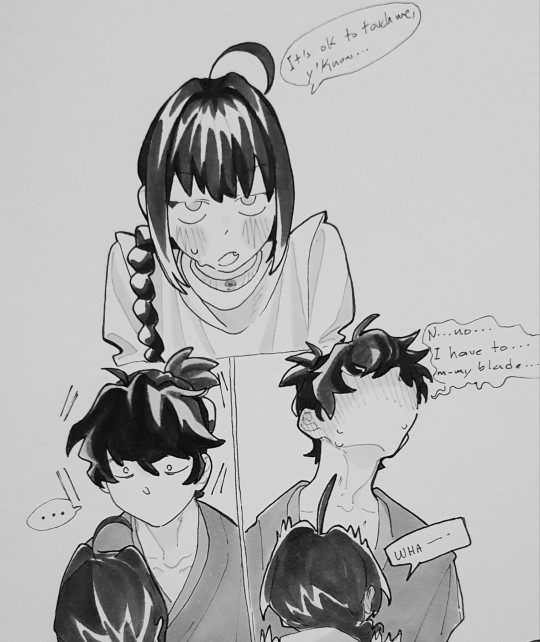

will you guys still like me if I go insane and crazy and bananas
#fate samurai remnant#miyamoto iori#saber#this is for all my fans (the two ppl in the tags of my previous drawing who wanted to see my iori/saber slop)#you don't understand i fell to my knees when i went to ao3 and all their fics were in chinese#im glad they are having fun over there but i want that for ME!!!! IM STARVING!!!!!!!#and that results in drawing embarrassing stuff like this
560 notes
·
View notes
Text

© Jake Likes Onions
#martial arts#combat#duel#sparring#humor#humour#martial arts school#swordplay#swordsmanship#chinese sword#sword#sword art#swords#jianfa#jian#katana#samurai#ninja#katana man#saber#daofa#swordsman#meme#meme humor#comics
11 notes
·
View notes
Text
I dunno much of anything about swords or swordsmanship outside of anime (Aka "make it look cool and that's all that matters") but I think it's more accurate to call Vesper's laser sword a laser saber than a laser katana, bc 1: it's a one handed weapon and 2: The shape of the laser blade and the length of the hilt are more like this (Chinese saber):


Than this (Japanese Katana):


I'll fully own up to this one as a lack of proper research on my part. I decided it wasn't a saber initially because when I looked up "Saber" they didn't look right at all, only to realize now that I was mainly just seeing modern dueling sabers and European-style cavalry sabers. I went with "laser katana" bc it was the closest I could find at the time, but it's also really not accurate. Does this mean that I've changed Vespers knockoff lightsaber from a "laser katana" to a "laser saber"? Yes. Yes it does.
#vesper tag#I've seen the chinese saber listed above called a yan ling dao saber but I've also just seen them called “chinese sabers” so I decided to#use the broader term to be safe#Bc I don't know how trustworthy the site using that name was
3 notes
·
View notes
Text
Loving Fate/Samurai Remnant so much actually. I love all the sword fighting. The gameplay is just so fun. But there r all sorts of informational things about 1600s Japan, specifically Edo and its neighborhoods and all sorts of cultural things, both big and small, and it's just. So Fun!!!!
I've gone looking some things up online for additional information on a few things, so I've learned things from that, too!!! It's just a really fun process
#speculation nation#AND since Edo is the old name for Tokyo. well now there are a lot of names i recognize from Tokyo#like ueno and akasaka and asakusa and MORE#inokashira was mentioned at some point and i was like 🥺🥺 omg 🥺🥺 i know that place#i dont think ive actually seen it tho. ive been to a few places but ya kno#ive learned about Yoshiwara and Kan'ei-ji and Nihonbashi and MORE...#i also learned about Tsujigiri. which i feel like i vaguely knew about like conceptually.#but when they mentioned a guy was being arrested for tsujigiri i was like 'huh?' and looked it up#and. yeah that sure is something someone would be arrested for huh.#it's interesting to play as such a law-abiding ronin. he's not afraid to rough people up but he prefers to avoid killing as much as possible#a pacifist through and through... unlike his sword-happy servant lmaooo#constantly having to talk Saber back from killing people while Saber is like 'i Know 🙄🙄🙄'#there is of course a fair amount of anime bullshit in the game. especially regarding magic and rituals and such#but all the frank cultural information lines up with what ive found online#so ive come to trust that That at least has historical backing.#im holding the People Of Influence with more of a scrutinous eye. simply bc fiction and its tendency to fictionize#though Fate also has a tendency to use major historical figures in ways many things would not. from what ive learned.#so Shrug. some of these guys might just be drawn from real people.#tho theres stuff like. Zhou Yu. the chinese military general. being made into an anime twink.#it's so funny actually. and Even Still it's making me learn more bc they include historical information in everyone's bios#(once we find out who they are lol)#i dont know if im gonna try to play any other Fates games. considering theres a Lot of em#but im having a lot of fun with this one at least 😃😃😃
1 note
·
View note
Text
Miao Dao 苗刀,是一種雙手持用的長刀,因其刀身修長如禾苗,而故名苗刀。(御林軍刀) 總長五尺、刀長三尺八寸、刀柄一尺二寸,又稱雙手刀或雙刀帶,是一種中國的單刃兵器,刀柄需用雙手持握。前身為倭刀與斬馬劍,起源可追溯至明朝,至民國時由曹錕定名為苗刀,其套路也定型為苗刀一路、苗刀二路、苗刀三路與苗刀四路等。
苗刀刀法最早在明朝晚期《辛酉刀法》、《單刀法選》與《單刀圖說》被書面記錄,中國歷史檔案館保存的重要歷史資料《苗刀考證》中寫到:「苗刀用以沖鋒陷陣,殺敵致果,遠勝單刀及其他短兵。迨明代戚繼光將軍,改鑄精絕。傳之于其部下,殺敵致果,斬將擎旗,賴以刀法,威震華夏。」 是中華民族的寶貴文化遺產。在中國北方,主要有通背拳與形意拳兩個系統傳授,在通背拳、劈掛掌、八極拳與形意拳等派別中各有套路。現存苗刀套路來自於河北滄州通背拳系統修改而成。
Miao Dao by amazing Han Liang 🥰🔥
#苗刀 miao dao#han liang 韓亮#wushu#chinese martial arts#kung fu#chinese leaf saber#chinese culture#kung fu world#kung fu girl#chinese weapons#thank you 🙏#💗
421 notes
·
View notes
Note
So just wanted you to know, "yellow" is a common slur against Asian Americans and so Huang Feng, being a Bruce Lee (whos an Asian man) clone and all could raise some eyebrows to your intentions. And before i get accused of white knighting, i am Asian
Thanks for reaching out! This is honestly something that might be important to discuss and I appreciate your attempt at broaching the subject delicately. More after the jump.
So to start. I am also Asian. Specifically Chinese American.
As an American born Chinese, I have a weird relationship with my Asian heritage. I have a bad accent when I speak Chinese and most of my upbringing and cultural understanding is very American and western-centric. So I have certain biases at play here that I fully acknowledge. My experience is not universal. But these characters are drawn from that experience.
Huang Feng is a reference to Bruce Lee's performance as Kato in the Green Hornet. Dà Huángfēng being a Chinese term for a hornet.
The character is also narratively implied to be a secret moonlighting identity for the Yellow Ranger in my made-up sentai team. (Who, due to my own decision to always refer to the characters by their Ranger color, is literally just called Yellow by the other members of the cast.)
This is also a reference. Specifically to one of my greatest inspirations, Thuy Trang (Rest in Peace), who played the original Mighty Morphin Yellow Ranger. She was one of the first "Cool Asian Characters" that I encountered in media targeted at me as a child, problematic color choice aside. I sincerely adored her and her giant robot Saber-Toothed Tiger.

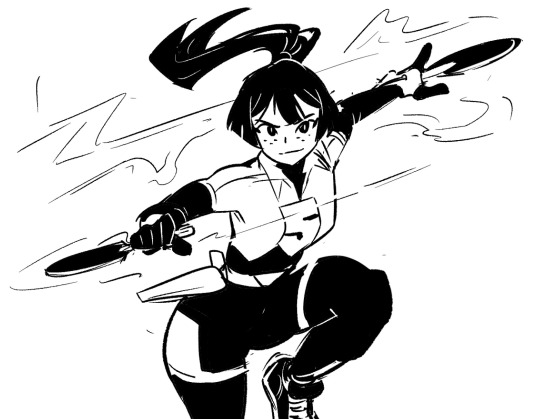
To be honest I have a complicated relationship with "Asian Themed" characters in media. So often saddled with cliché stereotypes: Martial Arts, dumplings, nunchucks, etc etc.
But the thing is, even as I roll my eyes whenever I see the Fighting Game character that is The Chinese One who wears a rice hat and a qipao. Or when one is literally just Bruce Lee. I do also immediately main that character. It's a bit of a guilty pleasure. Taking what representation I can get with mixed feelings. Similar to my enjoyment of sexy anime girl art even though it's all rooted in pretty uncomfortable sexist and objectifying aesthetics. A lot of my work comes from a place of exploring my own sexuality/identity. These characters are, partly, my own attempt to explore Asian themes and ideas for myself.
I would love to say that I'm trying to "reclaim" the term or something but I'm just some internet artist drawing cute anime girls and monster smut. For me, playing with these clichés is just another way of being self-indulgent.
Not really defending these creative choices so much as explaining my perspective on them. I totally understand if all this turns folks off! I fully respect those who don't vibe with my work and wish them all the best. It's a big internet and I'm sure they can find something super great to enjoy elsewhere!
Anyway, sorry for the long rambly post. Despite the fact that I'm posting this on Tumblr, I am not super mentally equipped to engage in Discourse, so forgive me if I don't respond to the tags on this.
So I'll just leave y'all with a neat article by Kat Chow discussing the history and usage of the color Yellow in regards to Asian Identity.
1K notes
·
View notes
Text
What kind of saber is baxia anyway?
I love my bloodthirsty princess of a cursed blade, and in my heart of hearts i am nothing but a sword nerd, so i've been extremely fascinated by Baxia and how we know frustratingly little about what she actually looks like!
I mean, look at bichen, right?
Bichen in the donghua:
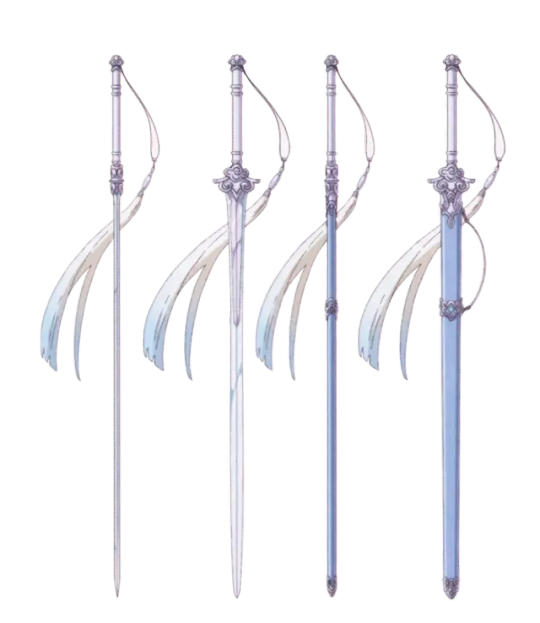
Bichen in the drama:
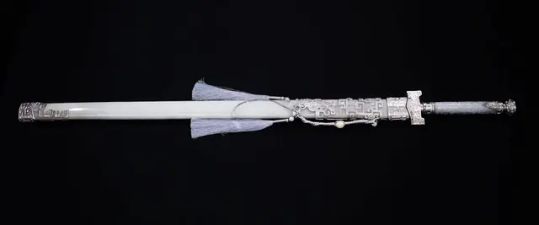
They're clearly not exactly the same. The scabbards are different, and the guards have a different shape. But these are recognizably different iterations on one theme, right? Thin jian with a white grip silver guard, light blue tassel and silver mounting accents on the scabbard.
Now this is baxia in the donghua:
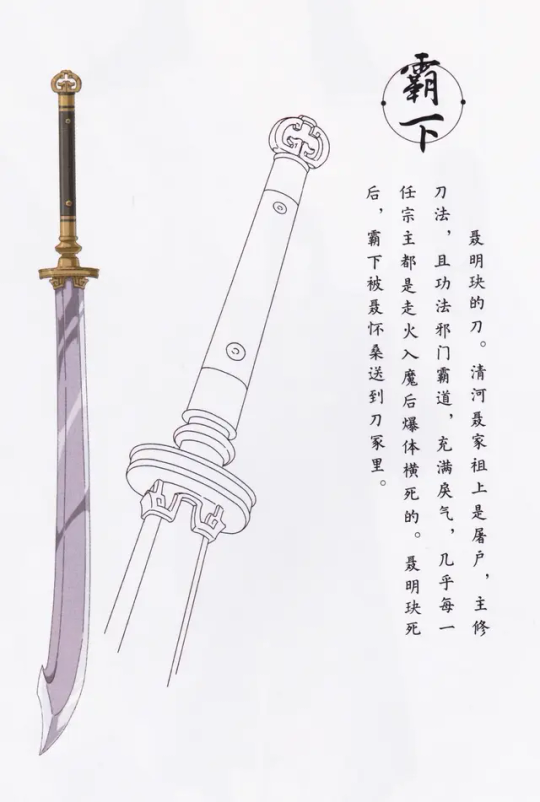
And baxia in the drama:
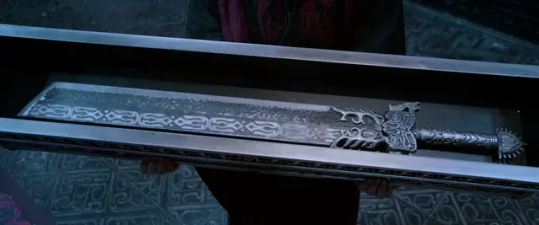
????????
THAT'S A COMPLTELY DIFFERENT WEAPON
it doesn't stop there either, the audio drama is kind enough to give us ANOTHER COMPLETELY DIFFERENT BAXIA
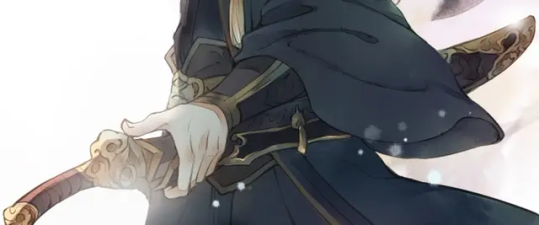
pretty! But how is that he same sword??
And when we go back to the novel, we get very little information on her appearance other than the fact that her blade is tinted red with all the blood she's absorbed. Which none of these designs incorporate.
This is not a dig on the designs itself, they're all quite gorgeous in their own right and i'm going to spend a while discussing all of them! Because isn't it fascinating how, since we know little about novel baxia beyond "saber" all of these designs ended up so different? What kinds of sabers are these, anyway?
So, a chinese aber, aka a "dao" (刀) just means a sword that has only one cutting side. As opposed to a jian, which has two.
You can see how that leaves a LOT of room for variaton.
I've actually seen some people get confused because Huaisang's saber in the untsmed is thin and quite straight, making it superficially resemble the jian more than drama!baxia, but it is still clearly a saber!
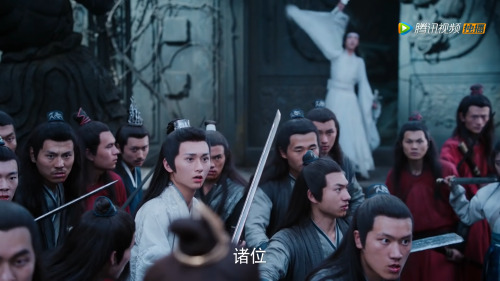
See? only one cutting blade!
This, to me looks a lot like a tang dynasty hengdao
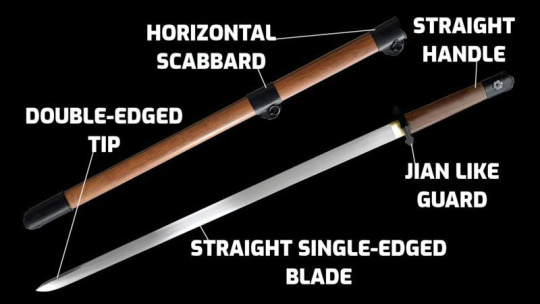
credit to this blog for providing his image and being a great source for all this going forward.
TANGENT: during all this I found out the english wikipedia page for dao is WRONG! Ths is what they about the tang hengdao!

So that sounds like the hengdao was called that during the sui dynasty, but then, after that, started being called a peidao, right?
WRONG
I LOOKED AT THE SOURCE THEY USED AND IT SAYS THIS:

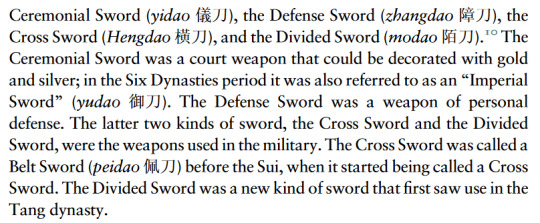
IT WAS CALLED THE PEIDOU UNTIL THE SUI DYNASTY, AT WHICH POINT IT WAS CALLED A HENGDAO. Which would carry over to the Tang dynasty. This was the source wikipedia linked! and it says something else than they say it does!
Anyone know how to edit a wikipedia article?
ANYWAY
BACK TO BAXIA
Since we're already at the drama, let's look at drama baxia: She's also straight! the general term for straight-backed saber is Zhibeidao, but that's a modern collector's term, and doesn't really say anything about which historical kind of saber baxia could be based on. Another meta i found on the drama nie sabers already went on some detail here.
I'm gonna expand on that a little: The kinds of historical straight-backed sabers we see resemble the hengdao a lot more than they do baxia. They don't go to their point as harsly as she does (she's basically a cleaver!) and they're all way skinnier.
No, my personal theory is that instead of being based on any kind of historical sword, drama!baxia is based on a Nandao.
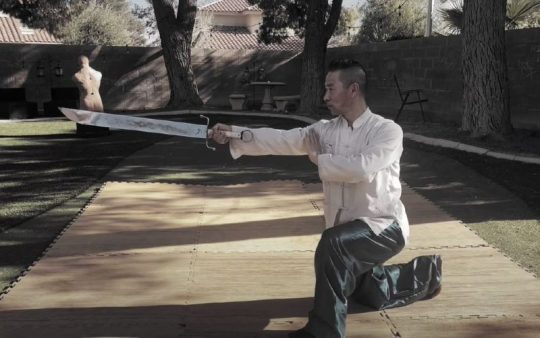
I mean, come on, look at it!
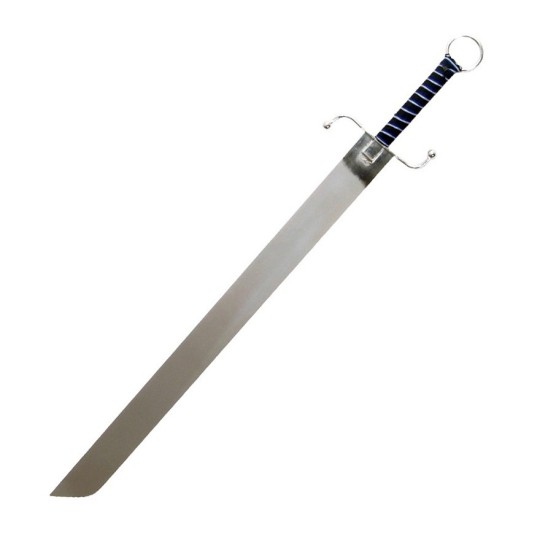
Baxia!
The Nandao... isn't actually a historical sword. It was invented for Wushu forms. There's a really fascinating article about its conception, but that's why the swords in the images look a little thin and flimsy. Wushu swords are very flexible and light, they're dance props, not weapons to fight with. There are actual steel versions of Nandao, but they're recreations of the prop, not the other way around.
So That's one way in which Baxia differes from the Nandao: she's actually a real weapon. The other is that, as you can see above, the nandao has an S-shaped guard. Baxia doesn't. She's also much more elaborately decorated, of course. Because she's a princess.
Now: audio drama baxia!
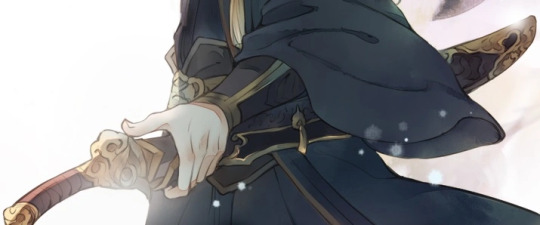
This is much easier. with that flare at the tip?
Oh baby that's a niuweidao, all the way!
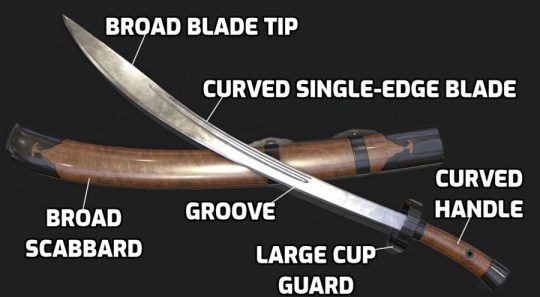
There are more sabers with that kind of curved handle, but the broad tip is really charcteristic of the niuweidao. The Niuweidao is also incredibly poplar in modern media, often portrayed as a historical sword, but it originated i nthe 19th century! And it was actually never used by the military!
That's right, the Niuweidao was pretty much exclusively a civilian weapon! That makes its use here anachronistic, but so is the nandao, and considering that the origin story of the Nie is that they use Dao intead of Jian because their ancestors were butchers, portraying them with a weapon historically reserved for rebels and common people instead of the imperial military is actually very on theme!
Finally, Donghua/Manhua baxia. These two designs are so similar I'm going to treat them as one and the same for now.
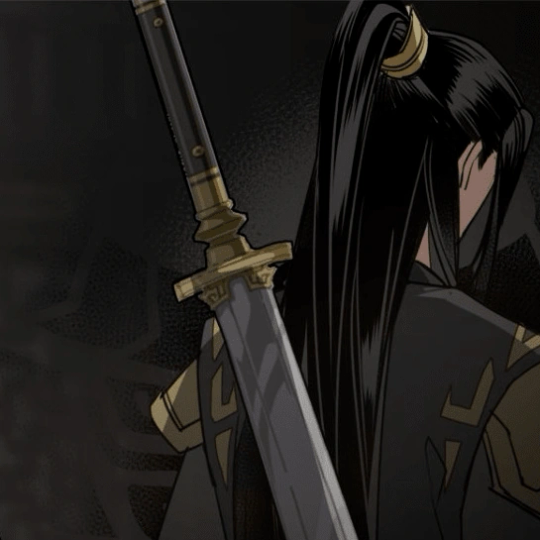
Unlike both previous baxias, The long handle makes it clear this baxia is a two-handed weapon, though Nie Mingjue is absolutely strong enough to wield her with one hand anyway. Normal rules don't count for cultivators.
Now, this is where things get tricky, because there are a lot of words for long two-handed sabers. And a lot of them are interchangable! This youtube video about the zhanmadao, one of the possible sabers this baxia could be based on, goes a little into just how confusing this can get. This kind of blade WAS actually in military use for many centuries, making it the most historically accurate of all the baxias. But because of that it also has several names and all of those names can also refer to different kinds of blades depending on what century we're in.
So here's our options: i'm going to dismiss the wodao and miandao, because these were explicitly based on japanese sword design, and as we can see manhua baxia has that very broad tip, so that won't work
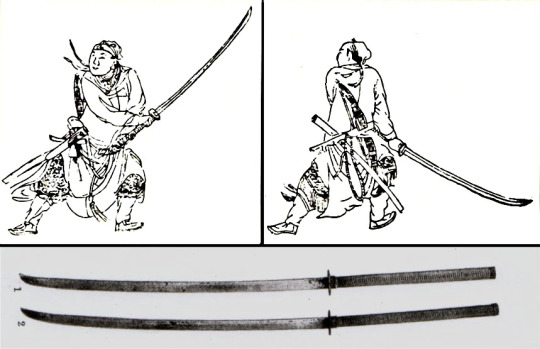
(Example of a wodao. According to my sources Miaodao is really just the modern common term for the wodao, and the changdao, and certain kinds of zhanmadao... do you see how quickly this gets confusing?)
Next option: Zhanmadao.
Zhanmadao stands for "horse chopping saber" so... yeah they were anti-cavalry weapons. meant to be able to cut the legs and/or necks of horses. That definitely sounds like a weapon Nie Mingjue would wield. But if you watched that youtube video i linked above, you'll know the standardized Qing dinasty Zhanmadao looked very different from earlier versions. It was inspired by the japanese odachi, and more resembles the miandao than its ealrier heftier counteprarts.
Earlier Ming dynasty Zhanmadao on the other hand were... basically polearms. the great ming military blog spot, another wonderful source, says these are essentially a kind of podao/pudao (朴刀) which looked like this
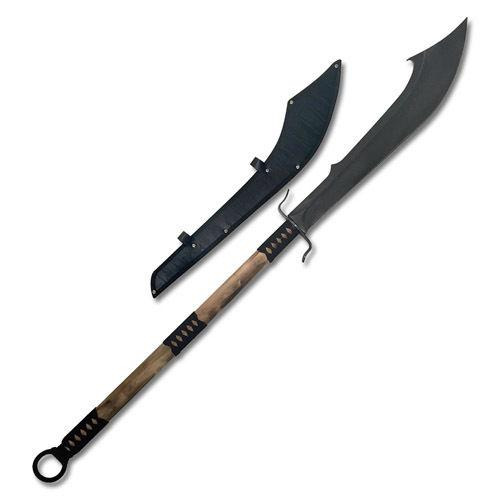
Now that blade looks a lot like baxia, but the handle is honestly too long. Donghua!baxia straddles the line between sword an polearm a little, but while zhanmadao have been used to refer to both long-handled swords and polerarms, this was undeniably a polearm, not a sword.
If you want to know what researching this was like, I found a picture of this blade on pinterest-- labeled as a "two-handed scimitar"-- and the comment section was filled with people arguing about whether this was a Pudao, Wudao, Zhanmadao, Dadao, Guandao, or a japanese Nagita.
So... that's how it was going. This has kept me up until 2 AM multiple times.
However! Thanks to this article on the great ming military blog I found out there have historically been pudao blades with shorter handles!
Specifically, Ming dynasty military writer Cheng Ziyi created a modified version of the pudao to work with the Dan Fao Fa Xuan technixues-- aka technqiues for a two-handed saber, which would alter heavily influence Miaodao swordmanship-- thereby, as the article points out, essentially merging the cleaver-polearm type Zhanmadao with the later two-handed japanese-inspired design.
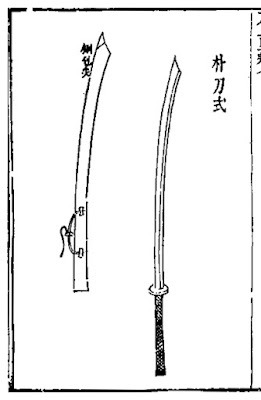
This is the illustration for the Wu Bei Yao Lue (武備要略) a Ming dynasty military manual
This blade shape in the illustration doesn't match Baxia exactly, but since it's a lengthened Pudao-like blade and we've seen above that those can match Donghua Baxia's shape, i'm gonna say that calling Baxia a Zhanmadao with a two-handed grip isn't all that innacurate!
However, because all of these terms are so intertwined, there are a dozen other things you could call her that would be about equally correct.
To show that, here's a lightning round of other potential Baxia candidates:
Dadao (大刀)
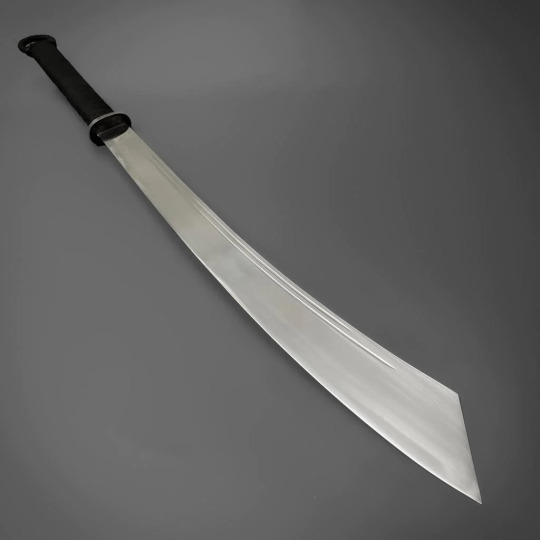
Which are generally one-handed and too short. However!
Another youtube video i found of someone training with a Zhanmadao that resembles baxia a little also calls it a "shuangshoudai dao" (雙手带 刀) shuangshou means two-handed, and while 雙手带 seems to refer to a longer handled weapon, when looking for a shuangshou dao or shuangshou dadao (双手大刀) we find a lot more baxia-resembling blades like here and here
I also found that, while the cleaver-like Dadao is strictly a product of the 20th centuy, since dadao just means big sword or big knife, it has been used to refer to loads of different weapons! Some people could've called the zhanmadao and pudao "dadao" during the Ming dynasty as well.
Another potential baxia candidate that mandarin mansion classifies as similar to the later dadao (though longer, as seen in the illustration below) is the "Kuanren Piandao"
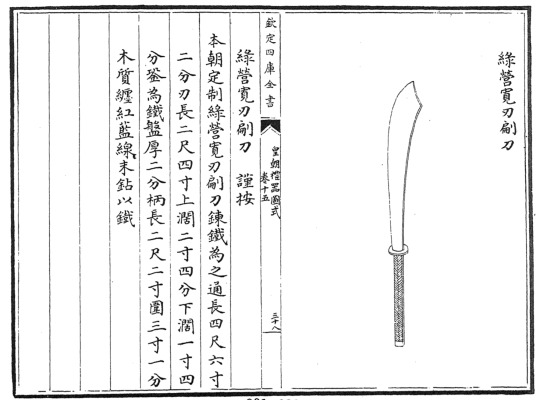
Which piqued my interest because this diagram classifying different tpye of Dao:
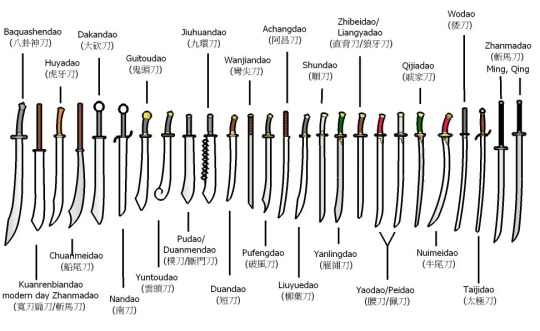
Claims that a Kuanrenbiandao (diferent spelling, same sword) is the same as a modern day Zhanmadao.
(So once again, all of these terms are interchangable)
Another opton Is the Chuanmeidao/Chuanweidao (船尾刀) below you can see a diagram, based on the Qing dynasty green standard army regulation, of blades all officially classified as types of "pudao"
The top middle is the Kuanren Piandao, and bottom left is the Chuanweidao.
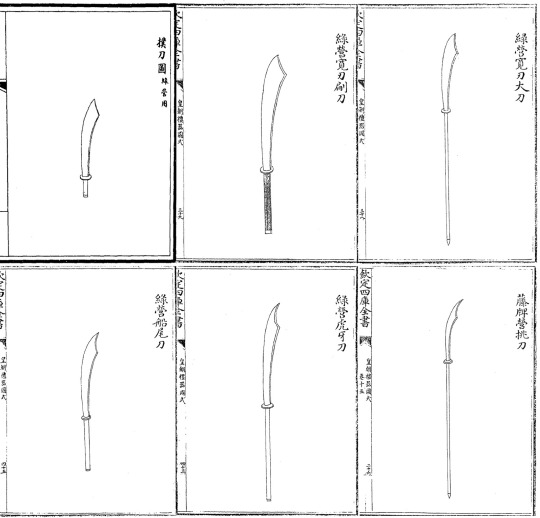
Both of these have a lot of baxia-like qualities.
So there you go! live action baxia is based on a Nandao, audio drama baxia is based on a Niuweidao, and Manhua/donghua baxia is some kind of two-handed Zhanmadao/Pudao/Dadao depending on how you want to look at it.
I'm honestly surprised no one has made the creative decision to portray Baxia as a Jiuhuandao, aka 9 ringed broadsword yet.
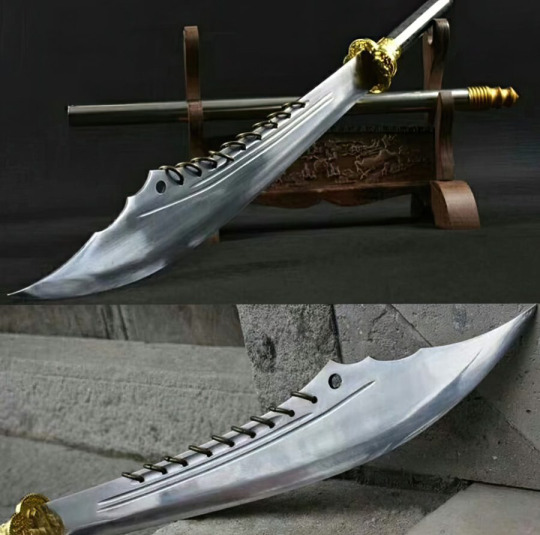
I mean look at it! Incredibly imposing. Would make for a great Baxia imo. (@ upcoming mdzs manga and mobile game: take notes!)
#mdzs#mdzs meta#nie mingjue#baxia#cql#the untamed#long post#I HAVE SO MANY TABS OPEN. FEEL MY SUFFERING#I understand that asking a gigantic region with thousands of years of rich history and many different subcultures#to have one standard naming convention is basically impossible#But could they do it anyway? for me? 🥺#i also want to buy one of these... so bad#or even just a plastic trainer so i can practice the techniques#but i know that once i start buying swords i'm not gonna stop until my money runs out#Being a sword nerd is a very dangerous not phyisically but for your wallet
557 notes
·
View notes
Text
Restless Rewatch: The Untamed Episode 41, part two
(Masterpost) (Pinboard) (whole thing on AO3)

Warning! Spoilers for All 50 Episodes!
Nie Mingjue and the Terrible Horrible No Good Very Bad Day
Empathy continues, jumping to Meng Yao and Nie Mingjue's encounter in Nightless City. Once again, let's look at how we saw it the first time around.

In Episode 22, Nie Mingjue unwisely decided to do a stealth advance push on Nightless City, as if "stealth" and "Nie Mingjue" ever belonged in a sentence together. After his inevitable capture, Meng Yao rocks up and says hey.
We cut away to the battle outside and then come back inside where NMJ hits MY with a palm strike.

Meng Yao actually expresses anger for once, knocking NMJ over with a kick, and yelling at him for being rude in front of MY's new boss, Wen Ruohan.

NMJ comes after him again but Wen Ruohan gets involved and the fight turns into NMJ vs. WRH until Nie Mingjue is knocked out. He ends up on the floor surrounded by dead or unconscious Nie cultivators; we don't see, at this time, how they got that way.
(More behind the cut!)
In Episode 41: the encounter in front of Wen Ruohan starts the same way, but Meng Yao taunts Nie Mingjue, fondles his shoulder, and then kills a couple of his wingmen.

Meng Yao--Wen Yao?--has never looked better. He's still rocking Nie braids and Nie colors - with a nice snake pattern trimming his robe. I'd like to say this is evidence of his snakey nature, but the idea that snakes are bad and sneaky is a biblical concept, not a Chinese one.
Anyway the important thing about his look here is that his makeup is gorgeous and his demeanor is totally confident. Unfortunately I can't find the tumblr post that talks about his sassy ex-boyfriend energy in this scene, but it was a wise observation.

Nie Mingjue's sidekicks provoke Meng Yao into killing them - one by insulting the hall they're in, and the next by calling him 走狗-- literally "running dog," but Viki translates it as "lackey."

"Lackey" is a little insulting but it's basically a job description, whereas Meng Yao's reaction to being called "running dog" is more like the way people react to being called "boot licker" in English. I'm not saying it should be translated this way, however - feet have a whole lot of meanings across cultures. I think it could have just been translated "running dog" because by 41 episodes into this show, we have learned that calling someone a dog is rude and insulting, thank you Wen Chao.
Anyhoo, after Meng Yao kills the second dude he asks if anyone else wants to call him 走狗, and Nie Mingjue immediately does. Meng Yao just smiles and has his own lackeys bring Baxia, in a fancy box, to him.

Then he fondles the blade while explaining that he's been spending some quality time with it. Nie Mingjue watches helplessly, unwilling to beg but afraid of whatever's going to happen.

Meng Yao tells him that his Dad's sword was better than his, and asks him to guess how many times WRH will have to strike Baxia to break it. I'm saying "strike," but Viki translates it as "smack" and Netflix translates it as "spank," with questionable results. How many times WILL Wen Ruohan spank it, I wonder?
Meng Yao taunts him some more: Wen Ruohan broke NMJ's father's saber and sent it back to him, which caused him to die of anger. He says this while getting up in NMJ's space and putting on an expression of ecstacy.

NMJ hits him, since that's his solution to everything; Meng Yao gets mad and kicks Nie Mingjue to the floor. It's not clear to me why Meng Yao talks so much shit if he doesn't want to get hit.
Aftermath
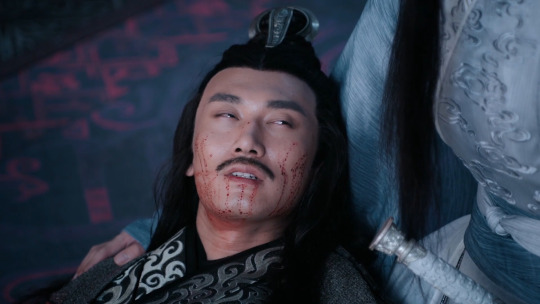
The confrontation where Xichen protects Meng Yao is the same as episode 23, up to a point. Nie Mingjue wakes up in Lan Xichen's manly arms and has a moment of happiness before seeing Meng Yao standing by holding Baxia.

NMJ goes to attack him but Lan Xichen protects Meng Yao and explains his whole spying gig -- calling him A-Yao, which has gotta chap Nie Mingjue's ass.

Lan Xichen can block a blow from Baxia one-handed. Hot.
There's a nice parallel here, where Meng Yao uses Lan Xichen as a human shield, similar to Wei Wuxian using Lan Wangji to protect him from Fairy in Episode 34.


Wei Wuxian is, of course, way more handsy about it.


Meng Yao passive-aggressively tells Lan Xichen that he didn't explain his actions because that big meanie Nie Mingjue wouldn't have believed him anyway, and then he kneels in front of Nie Mingjue. That's as much as we got of that whole encounter, in Episode 23.
In Episode 41, after Meng Yao kneels, he explains his situation and said that he only said all that dickish stuff to Nie Mingjue to gain Wen Ruohan's trust, and he's sorry about hurting his feelings.
Nie Mingjue says how about you kneel to those dudes you killed.

Lan Xichen tells Nie Mingjue that yes, A-Yao did horrible things, but I believe that in his heart he… we don't hear the rest because Nie Mingjue interrupts by destroying a lantern, but we don't need to hear the rest because it's the same thing Lan Xichen says all the fucking time; it's become his core belief in the years since.

Meng Yao is surprised that it's the lantern that died and not him, but Nie Mingjue is in an impossible situation. Meng Yao has recruited Xichen so completely to his side that if Nie Mingjue wants to stay friends with LXC, he has to accept Meng Yao . You can see in his face that he knows he's beat.

Continued in part 3!
#the untamed#the untamed gifs#canary3d-original#restless rewatch the untamed#nie mingjue#lan xichen#meng yao#another enormous episode that i had to break in three#darn you tumblr paragraph limit
110 notes
·
View notes
Text
Reading TGCF: Chapter Twenty-Five

For those who don't know, I am reading TGCF for the first time and sharing my thoughts!
If you have not read it, there will be spoilers! Consider this a warning.
Also- if you want to follow along, I am aiming to post updates daily. You can find all the posts in the tag Bloopitynoot reads TGCF. You can also check out the intro post for context on my read BUT if you followed along with my SVSSS read, the rules and vibe are the same.

Yall I downloaded 小红书/Xiǎohóngshū/Little Red Book/Rednote and have been vibing there for a week. I finally uploaded my first little vlog and and it was the process of me reading this chapter (while watching the sunrise).
Skylar (my partner) and I have been (very) slowly learning mandarin and I am super trash at it, but being on 小红书 has inspired us to learn mandarin proper. So give me like 4 years and maybe i'll be at a place where I can read mxtx in Chinese. No promises, but now I have goals!
Today's tea: almond, rose, & amaranth
Let's go chapter 25!
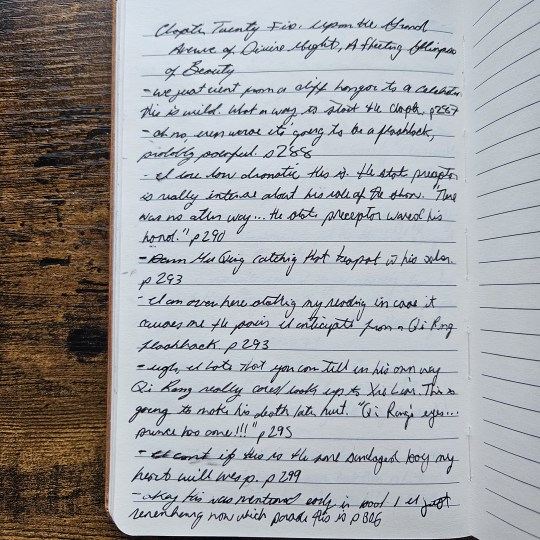

We just went from a cliff hangar to a celebration, this is wild. I need to know what's happening with Qi Rong. What a way to start the chapter. p287
Oh no, even worse, it's going to be a flashback, probably painful. p288
I love how dramatic this is. The state preceptor is really intense about the role of the show. This is so much drama, he's just over here sweating, "There was no other way. Bringing out a grand stage without the God-Pleasing Marital Warrior was death; delaying the procession and missing the fortuitous hour was also death. Despairingly, the state preceptor waved his hand." p290
Damn Mu Qing catching that teapot with his saber. p293
I am over here stalling my reading in case it causes me the pain I anticipate from a Qi Rong flashback. p293
Ugh, I hate that you can tell in his own way that Qi Rong really cares/ look looks up to Xie Lian. This is going to make his death later hurt. "Qi Rong's eyes were shining bright, his face red. He jumped up and down , shouting, "Cousin Crown Prince! COUSING CROWN PRINCE HAS COME!!!" p295
I can't if this is the same bandaged boy my heart will weep. p299
Okay this entire memory was mentioned in book 1 and I am now clocking it; I now remember which parade this is and boy I am expecting the next chapter (if the flashback continues) to perhaps hurt. p306
We had some sneakiness from Mu Qing
our boy Xie Lian totally thought he cleared his entrance with the state preceptor; is this some sabotage from Mu Qing?? Also he was not so chill during their staged fight. I have sus feelings about this man.
#bloopitynoot reads tgcf#mxtx tgcf#tgcf#tgcf spoilers#mu qing#this sneaky man#xie lian#qi rong#I am stressed#i was told these chapters would be a break from trauma#yes here I am nervous as hell
35 notes
·
View notes
Text
Just A Little Thing - A Copia/You Ficlet
I'm enjoying these Copia and you fics. Here's a fluffy wuffy one talking about how you and Copia came to be more than friends...or the stirrings of it. I promise part two of The Birthday Gift is on its way as are the others I'm working on. But this little idea came to me and I had to write it.
You can read here or also at AO3



You had to buy it for him. It was just too perfect. Drat Vader, a little plastic doodad of a rat in a Darth Vader helmet. It was even flocked. He was holding a tiny light saber in one hand and a piece of Swiss in the other. It screamed loudly Copia in every language known to man.
You hadn’t seen him in a few weeks as he was on tour. It was the big one, the one ending in LA for a two-night stay. You’d finally got the time to come to a stop and so you were going to see him and the gang in Vegas. Sin City may not be ready for a group of rowdy ghouls and a Papa like Copia, but it promised to be an insane time.
Copia had pulled rank and said they all deserved a rest after this show. They’d been going nonstop for a few months. So after the ritual it was a play day for everyone. When you arrived it was nearly the end of the performance sadly thanks to a flight delay. But it didn’t matter, you watched the man who had become your best friend give it his all to the crowd.
Ashley saw you and came bounding over giving you a hug. “Thank god you are here. He’s been even moodier than usual.” She said, exasperation evident in her voice.
You squeezed her and after the hug you asked her. “What’s been going on?”
“He’s the same Copia but when you aren’t around, he’s just…more broody. Also he’s been on edge lately. Just…I’m happy you are here.” Ashley gave you a smile and headed off to check the next wardrobe change.
You looked worriedly out to the stage where Copia was making the asses wobble with Kiss The Goat. Ashley’s words echoed in your head. You worried about your friend. Copia was always walking a fine line in his own head. Sometimes the anxiety would win. And those times you were glad you could help him take his mind off things or listen while he vented what was wrong. Hopefully your presence wouldn’t make things worse but better like Ashely had said. Whatever you could do and maybe Drat Vader would make him laugh.
You watched and listened as Dance Macabre started. It was your favorite, and you knew Copia would kill as he always did with it. It was amazing as expected, and Copia was a blur of sky-blue sequins on the stage from where you could see. He always gave everything on that stage. You’d seen the proof before. He’d be exhausted and drained and you’d try your best to get him back to normal. Sometimes it was more difficult than others.
When the song started coming to an end you knew that the encore was over. You quickly moved to a corner out of the way as the applause and cheers echoed from the venue like thunder.
The Ghouls came in first heading to their area to collapse and recover from the show. They were chattering away, and you grinned as you watched them, hearing them talk about hitting the casinos hard tonight and the challenge of an all-you-can-eat buffet.
Some poor Chinese restaurant was going to be put out of business this evening you had a feeling.
You heard Copia before you saw him. He came into the backstage area, and you saw Ashley quickly move to help take his Encore Jacket off to store it safely for cleaning. “Good show yeah? You think? It felt like a good show.” He was saying to her.
“Very good show.” Ashley replied, shaking her head at how someone who just got a massive standing ovation could still doubt their performance the way Copia could.
The Papa turned and sat down heavily at the dressing vanity, staring into his own mismatched eyes. The face paint was starting to get a little faded. Out of habit he added a bit more powder to the white while noticing another bit of grey at his temples. His lips thinned at the sight.
“Maybe I should follow at least one example Terzito set, eh? Dye the hair and flip off time.” He muttered to his reflection. He was feeling every one of those grey hairs this night. He was glad he had decided to give a rest day to everyone, including himself. He loved being Papa, he loved the stage which is why he gave it his all every night. But when you feel like there is nothing left of yourself for yourself…it was time to take back some of it.
Copia’s thoughts wandered, of course going to you. He missed you. The tour would be far easier if you were around to keep him grounded, which seemed to be more your job than assisting with the publicity team. If you were here, he could take you to Madame Tussaud’s and together you could pose suggestively with the statues or get ridiculous with them. Go to Circus Circus and watch the acts. A voice in his head said very quietly “Get married by an Elvis Presley lookalike and spend the honeymoon night in a suite with a heart shaped hot tub.”
Copia’s eyes widened at that thought as it scurried away into the recesses of his brain. Where had that even come from? Dark Lord…that was…not appropriate. Nor was the fluttering in his chest at the imagined picture of you wearing a black bridal veil looking stunning in a lacey black dress while he slipped a band on your finger while the ghouls all cheered as they witnessed it. The fluttering spread to every part of his body…and apparently the blood flow also followed it as the image of pulling you into his arms and kissing you filled his vision. Bending you backwards and cradling you in his embrace, officially his…propriety be damned. You’d taste like cherries and sugar…
The Papa shook his head vigorously. This was how tired he was…thoughts like this had been bothering him so often of late. You were his bellissimo amico. Not his paramour, not his amante. You were his friend, and he had no right to think of you in that way and Satanus knew how you’d react if you found out he was even having these…daydreams? Thoughts? He’d lose you no doubt…you’d run away with every right to, and he’d lose one of the best, most precious friends he’d ever had. That he could not bear. Copia closed his eyes, head falling forward and sighed heavily.
Ashley sat his silver cup next to him, causing him to look up. This time he could smell the bit of whiskey mixed in with the tea and lemon. “Satan bless you.” He said as she patted his shoulder.
“I think you might want to turn around.” She said grinning and then headed off to double check the packing of the gear.
Copia glanced in her direction, perplexed and then turned around in his chair.
When his eyes met yours, you waved. “Hey, uh..surprise!” As you watched Copia’s gaze widened in a mix of disbelief and shock.
Copia stood, uncertain if he was dreaming. “Cara?? You…you’re here??” he quickly put his cup down on the vanity and practically skipped over to you, no longer as sore from the concert. He threw his arms around you, nearly spinning you in a circle.
“Aaaa!!” You let out a happy shriek as he squeezed your ribs into pieces. “Yes! Yes I’m here you lunatic.” You laughed.
Copia stopped dancing you in a circle but didn’t let go. He was grinning from ear to ear. “Si, you do drive me crazy dolcezza but in a good way.” His eyes, though still tired, were sparkling with more life than before. “You surprise me when I most need it, Grazie.”
You searched his face, seeing the exhaustion that was creeping in. You reached up and touched his painted cheek lightly. “You look tired Papa.”
Copia grabbed your hand, holding it in his gloved one. “I’ve told you before cara, when it is you and I, I’m simply Copia.” He placed a quick kiss to your knuckles, and then sighed, keeping hold of your hand and leading you both to the velvet covered couch in the corner.
You both sat down, Copia grabbing his silver cup of more whiskey than tea. Ashley was serious about him resting or simply collapsing based on the mix. “Si, I am tired. This has been a long tour and…it feels as though…well…” He took a drink, letting the burn flow down his throat into his chest.
“What’s on your mind Copia?” You asked him, watching as he stared into nothingness for a moment.
He looked over at you, your eyes so open, so kind. You’d come all this way just for him. Those thoughts from before came unbidden again and his gloved fingers flexed where they rested on the black velvet cushion. He sighed heavily. “It feels like…something…big…is coming. I don’t know cara…I just have a sense of something on the horizon.”
You’re brows narrowed in concern. You touched his black sleeved arm. “Something good or something bad? You’ve always been a little psychic Copi.” You asked him.
Copia felt the warmth of your touch through the soft fabric of his shirt. It helped to settle him a bit. “I don’t know tesoro. Eh, I’m not that good of a psychic.” He laughed softly. “If I was, we are in the right town si?”
You shook your head. He was trying to get you to not worry but it was too late for that. “Copi…wait…is that like 100 percent whiskey your drinking?” You asked, the scent hitting you suddenly.
Copia glanced down and gave a slight chuckle. “I think Ashley got a little bit too excited about the…is this, Jack Daniels?”
You took the cup from him and took a sip, eyes bugging out of your head. “cough…Yeah…that’s…cough….Jack Daniels. I think she gave you most of a bottle.”
The Papa chuckled. “I think she’s trying to help me sleep. I…I’ve not been able to rest well for…well…the last few weeks.” His voice grew softer as he spoke, the exhaustion leeching into the words.
You winced at the sound, a sharp little pain hitting your heart. “Well tonight you’ll get some sleep, or be in an alcoholic coma if Ashley has any say apparently.” You put your arm around his shoulders and gave him a brief squeeze.
Copia sighed, letting the scent of your perfume fill his lungs, the warmth of your embrace settle into his bones. Just this and he could feel the anxiety running away along with the worries of the last few weeks. He wanted to rest his head against your shoulder, pull you into his arms and lay back on the couch for a long nap. But that was another of those daydreams and he would not lose you to his own flights of fancy.
You remembered your gift suddenly. “Oh I almost forgot!” You said and stood, moving to where you had left you backpack.
Copia nearly fell over onto the couch he’d been leaning so close to you. He caught himself before he could become a complete embarrassment. He missed your warmth immediately. “What…what did you forget?” He managed to ask, taking another drink of Ashley’s concoction.
“I got you a gift. I think it might make you feel better about things….or at least laugh.” You pulled the small gift bag out of your backpack and headed back over to the couch.
“You already make me feel better cara.” He said watching you settle back next to him, his eyes glinting with the sheen of exhaustion mixed with affection and a little whiskey. “You’re the only gift I need il mio bel regalo.”
“Whatever you said, just hush and open it. I hope you like it.” You handed him the little gift bag, the same color as his favorite concert jacket, a dazzling blue.
Copia smiled, setting his drink on the table. He carefully pulled out the tissue paper and unwrapped the little lumpy figure inside. When he saw the little Dark Side rat his heart felt as if it had grown too big for his chest. “Dolcezza…he’s…he’s…”
“He’s a buddy for the road…he’ll watch out for you when I’m not around with his special Sith Cheese powers. Drat Vader will take on all comers.” You told him, watching his face as he studied the little rodent.
Copia felt tears pricking his eyes. Of course she would pick something this perfect…would know him this well. “Sith…Cheese.” He repeated smiling.
You bit your lower lip, still unsure. “I know it’s just a little thing…but he seemed like he needed a home…I hope you like him.”
The Papa turned to look at you a grin on his painted lips. His expression was wistful and almost disbelieving. “Like him? I love him tesoro. He’s perfect, just like you.”
You blushed, not able to stop it. The way he was looking at you and the compliments…it made a little shiver in your chest. You needed to be careful. You’d really missed Copia in the days he’d been gone. You were realizing just how much you’d come to rely on him to not feel alone, to talk to. He was everyone’s Papa in the ministry and while you weren’t a church member…you knew what that meant. He was shared to all who needed him…you weren’t special.
One time you’d said this to him when you’d had a particularly bad day regarding your crazy family. A phone call had set you off and you’d called out sick for the rest of the day, heading back to your quarters and curling up in a ball. Sometimes it could get a little much.
As was his special super power, Copia somehow knew you were MIA. Phil must have told him you’d left because an hour or so into your crying jag there was a gentle knock at your door followed by a softly accented voice asking “Cara, it is me…can I come in?”
He’d have stood out there all day if you hadn’t let him in. You knew Copia…he was stubborn. When you opened the door, he was standing there in a blue velvet tracksuit with a probably vintage Black Sabbath shirt, sans his papal paints. His darkly circled eyes found yours, red and puffy from crying. His face immediately looked stricken. “Oh…tesoro…I am too late to stop the tears.” He swept you into his arms, hugging you tightly. “I am here now though…no going anywhere cara.”
Still holding you he pulled away to tilt your chin up to meet his eyes. “I have ice cream, Ben and Jerry’s and Chopping Mall on DVD. You are going to have chocolate and schlocky goodness with me, si?”
You’d shaken your head. “I’ll…I’ll be okay.” He didn’t need to drop everything for you like this. You’d sniffled, hating how it could hit you so hard after so long. “You’re Papa and you have a whole flock of people that you have to take care of.”
He’d given you the strangest look then, grasping your chin once more. “I told you before cara…for you I’m Copia, always. And you are il mio adorabile amico. And I take care of my friends because…well…they are rare gifts the dark lord has bestowed on me. And you are one of the most treasured I have. If I neglected you cara, Lucifer would kick my balls…he’s got hoofs…it would hurt. And he’d be right to do so.”
You laughed, not able to help it. He already could do that with just a stupid joke and a hug. He’d caught your eye again, smiling. “Eh! I heard a laugh. See…you can’t send me away now. It’s the rules…I get you to laugh you have to watch a movie where robots murder teenagers in a mall.”
“That’s a very specific rule Papa.” You’d replied.
“Bah, I told you…Copia for you…you have special…access.” He’d tried to figure a word for it, but access actually sounded sort of…dirty now that he thought of it.
“Oh, special access? What does that entail?” You’d asked him batting your eyes playfully.
Copia had to pause a moment at that. Oh…that…that was not an appropriate response, and he would not voice what had gone through his head. “Eh, don’t you worry about it…just…know you got it.”
For a moment you paused and then nearly toppled him with a hug. You couldn’t help it; he was just so Copia. Sweet, caring, fiercely protective and right then he smelled really good and was cuddly as hell in the tracksuit. He was like your own sky-blue satanic teddy bear.
“What is all this…eh?” Copia managed to stutter out, surprised by the hug but it was not unwelcome. He wrapped his arms around you and squeezed.
“Thank you for my special access.” You muttered against his shoulder. “You’re…you’re my best friend…just thank you.”
You couldn’t see it at the time, but Copia’s eyes had grown watery, tears swimming in the green and white of his gaze. No one had ever said what you had to him just then. Never best friend, maybe rarely friend. But never this. He closed his eyes, one single tear breaking free from beneath his black painted lid. It smeared his cardinal paints slightly, just the slightest trail. He quickly wiped it away with a gloved finger, not wanting you to see what a silly old fool he was.
“Prego cara mia.” He said softly, almost a whisper because he didn’t trust his voice not to break just a little. “E mio onore.”
The memory was bittersweet. The time spent with Copia, stuffing yourselves with New York Super Fudge and watching the 80s literally play out on screen was so sweet. You felt like a teenager again. But the bitter was there. The screaming of your sister over the phone about how you were going to burn in hell…you could nearly smell the beer on her breath through the receiver.
You wouldn’t think about that now though. Copia was here in the present. He and the ghouls and Phil were your little tribe now. “I’m far from perfect Copia, but Drat Vader is.” You told him grinning.
Copia shook his head. “Bah, you are perfecto. You know me too well cara. I am glad you are here and now I have a little buddy for the bus to keep me company…it will make the time away from the bambinos easier.”
“Oh the babies say hello by the way.” You told him, having been checking on them while he was gone. You pulled out your phone and quickly pulled up the couple of pictures you took before leaving. “Phil promised to take care of them.”
Copia smiled at his little babies. Rigatoni was shoving his furry face into the camera. He glanced over at you, seeing your eyes reflect just as much love for the little rascals as he felt. It made a sweet little pain hit his chest. He sighed. “They look as mischievous as ever.”
“Oh they are…you never told me how much an escape artist Rigatoni is. I had to add a lock to the door.” You put your phone away, shaking your head.
“That’s on me…” Copia said nodding. “He’s my Houdini. He’ll hate the lock…eh, he’ll probably have it figured out in a day.” The Papa already felt better than before…and also maybe a little drunk since he hadn’t eaten prior to the show and had been drinking down the whiskey laced with tea for a few minutes. He glanced over at you and smiled loopily. “I’m glad you are here dolcezza. Grazie for this.”
“Grazie for what?” You asked smiling, eyes meeting his heterochromatic stare. He looked sleepy and a little plastered. You didn’t know if you’d ever seen Copia drunk before…that would be an adventure.
He waved one gloved hand around in a shaky circle. “This…all of this. You coming to see me. Il mio piccolo Sith Lord. Just…you. Grazie.” Copia’s voice light and the words only a little slurred.
He then leaned over to kiss your cheek, but you didn’t know he was going to and when his lips connected it wasn’t with your cheek but the corner of your mouth. You stilled, a shock of heat going up your spine as his warm, sweet whiskey scented kiss pressed against you. You froze, a little squeak of surprise in your throat.
Copia pulled away almost immediately, the flush of his blushing visible even through the face paint and definitely on the slightly pointed tips of his ears. “Mi dispaci…I…my aim…it was…off.” He stuttered, trying to forget quickly how soft your lips were and how they’d felt even for that brief moment. The booze was affecting him…that’s what it was…not the fact he’d just kissed you…a real kiss…and it had made his heart stop for that moment.
You hoped your face wasn’t on fire…oh god…please don’t make me look like a strawberry. “No…no worries…it’s okay.” You laughed nervously, trying to forget that spark of heat that had flooded your entire body.
Copia felt like a louse. This was exactly what he shouldn’t be doing. He would scare you off…you who had been this kind to him…and he was being un fottuto idiota. He glanced to you once more and noticed he’d left a black mark behind from his ill aimed kiss.
“Perdonami,” he said softly and reached over with his gloved thumb and very gently wiped away the evidence of his lips on yours. His gaze was caught in yours as he did, trapped and he found happily so. Oh…this was…not…appropriate.
“Okay Papa, time to change.” Ashley bounded back just in time. “I need these ready for cleaning. Your clothes are laid out behind the curtain.
Copia quickly turned at her arrival. You felt like you were just shaken from a dream, what was going on? Why were you leaning towards him like that? Why was he leaning towards you like that? Oh…not…not appropriate.
“Ah, grazie Ashley.” Copia managed to say, sitting up quickly. He turned back to you. “A few minutes cara, then we go and get something to eat, si?”
You nodded still dazed a bit.
Copia headed behind the dressing area’s divider and took a breath. Ashley had lain out his red track suit this time and a Scorpion’s t-shirt with his dress shoes. Good choices. He found himself leaning heavily against the black wall, his head falling back and gazing up at the cavernous ceiling of the venue.
What was happening? He couldn’t…he couldn’t be…this was…you would never… He thunked the back of head against the wall a half-hearted attempt to knock the thoughts away he was having. Instead he just hurt himself and winced, “Eehhh…” he muttered, rubbing his now sore head.
Without thinking Copia brought his gloved thumb to his lips, licking away the mix of his paints and your lipstick. He closed his eyes and sighed at the taste combined on his tongue, sweeter than any whiskey or honey. “Amore…” He whispered softly to himself, realizing there was no fighting this any longer. “Please…please don’t run away.”
#the band ghost#tobias forge#ghost#cardinal copia#papa emeritus iv#ghost fic#ghost fanfic#copia and you#copia and reader
22 notes
·
View notes
Note
All these demons! Reader au idea and their classes or sins gives me flashbacks to my fave series Fate/Series (Fate/Stay Night) with their own "demons" known as Servants/Heroic Spirits.
Like the seven sins idea gave me the seven classes (Saber, Archer, Lancer, Caster, Berserker, Rider).
The moment the reader was summoned they probably pulled off some cool and scary dramatic entrance and said "Class of Sin: Wrath... I heard the sounds of a call to be summoned. I ask of you, are you my master?"
The curse mark on Percy can be seen as a command seal (only three can be used at a time). In my mind.
Sorry if I was blabbering on some nonsense, here's a headcanon I wanted to share!
Reader getting angry with Percy if he were to pet another cat.
(My cat always HATES it whenever I come home with a different cat scent on me.)
Percy calls reader "Mama 2".
Surprisingly I've never watched any of the Fate series or anything about it, but it sounds neat! I'll have to check it out some time ^^
Also I love the idea of Reader saying some cool one liner as they get summoned. Like Sebastian from Black Butler, or something like that [I forget if there were any other ones I've seen]
Also, Reader definitely gets a bit jelly when Percy pets other cats. Like the quiet kind of jealousy where Reader says nothing about it to Percy but replaces his jackets with theirs so he gets their scent. [When I said these demons were like pack animals I kinda meant it, scenting is really important to demon folk. They like to give their family members stuff with their scent on it just so other demons know who belongs to what family. ]
While Percy holds his mother in high regards, he also really likes Reader as a parent. Since Reader doesn't have a set gender [cause they can change their form into anything they want] Percy has a handful of names he likes to call them. Like, Mama or Dad, and all that jazz. [Not father though, that one is meant for Bruce but in a really mean way. Percy is just petty like that]
But sometimes Reader doesn't feel like a parent to Percy, sometimes they feel more like a sibling or an uncle. So Percy calls them as such, like gēge, or jiějie on the rare occasion. [Idk if I typed that out anywhere but Percy's moms side of the family is Chinese, and while he's not fully into the culture he still takes part in some of it. Hence why he calls Reader by the Chinese terms of older brother and older sister. Never younger though because it's Percy's job to be the younger sibling.]
#x gender neutral reader#x reader#platonic yandere#platonic batfam#candysparks answers#Demon! Reader
23 notes
·
View notes
Text
CHINESE EMPIRE AU TOKYO REVENGERS
More parts here


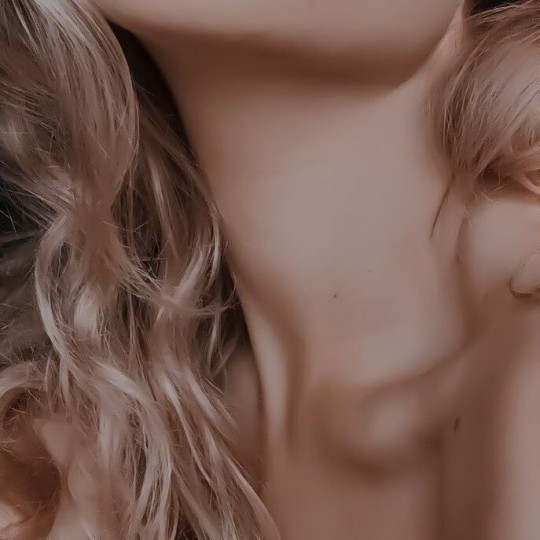

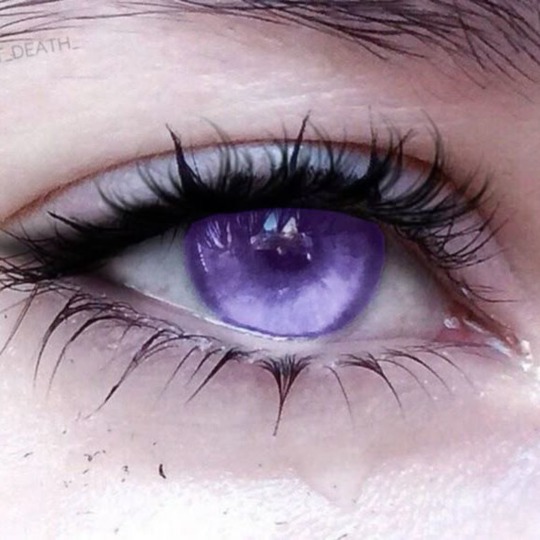




Rindou Haitani
ENGLISH
Rindou is the youngest daughter of the noble Haitani family.
She lives under the constant pressure of her father to find a husband who can financially save the family. However, more than anyone, she knows that her father would sell her to the highest bidder just to get as much money as possible.
She loves her brother and mother more than anyone in the world and is eternally grateful to them for protecting her from her father’s horrible plans.
She has a good relationship with her mother, who has taught her many more things than a young unmarried lady of her age should know.
With her brother, she has a very close relationship—he is her greatest confidant and best friend, the one who knows all her secrets.
The biggest secret the siblings share is Rindou’s magic—she controls water and ice. More than once, due to nerves, she has frozen the ground beneath her feet.
Luckily, she has only frozen a very small part, and no one has ever noticed—except for Ran, whose foot she once accidentally froze, causing him to let out a small yelp from the sudden cold.
After that accident, Rindou tried to control her powers and keep them a secret.
One of her greatest passions is music—she practices every day with her Guqin (a musical instrument of the time).
The only thing the whole family agrees on is her enormous musical talent. However, her father often wants to use it to show off and find her a husband.
Another of her hobbies is training with Ran. In secret from their father, he taught her how to fight so she could defend herself if he wasn’t around.
What Ran didn’t expect was that his sister would become almost as strong as him.
Despite her father’s constant pressure, Rindou hopes to marry the one she loves—Seishu Inui.
Unfortunately for her, their father seems to dislike the Inui family, so the chances of him approving her idea of marrying Seishu are practically zero.
But that hasn’t stopped her from trying to get to know Seishu better.
Luckily, she has been able to keep her little nightly escapades with Seishu a complete secret.
ESPAÑOL
Rindou es la hija menor de la noble familia Haitani.
Vive bajo la constante presión de su padre por encontrarle un marido que salve económicamente a la familia.
Aunque, ella más que nadie, sabe que su padre la vendería al mejor postor, simplemente por conseguir la mayor cantidad de dinero posible.
Quiere a su hermano y a su madre más que a nadie en el mundo, y les está eternamente agradecida por protegerla de los horribles planes de su padre.
Tiene una buena relación con su madre, quién le ha enseñado muchas más cosas de las que una señorita de su edad (y soltera) debería saber.
Con su hermano tiene una relación muy buena, es su mayor confidente y su mejor amigo, quien sabe todos sus secretos.
El mayor secreto que tienen los hermanos es la magia de Rindou, quien controla el agua y el hielo.
Más de una vez, por culpa de los nervios, ha congelado el suelo bajo sus pies. Por suerte, solo ha congelado muy poca parte y nunca nadie se dió cuenta.
Menos Ran, a quien le congelo parte del pie y soltó un pequeño chillido por el frío repentino.
Tras ese accidente, Rindou intentó controlar sus poderes y mantenerlos en secreto.
Una de sus mayores aficiones es la música, práctica todos los días con su Guqin (instrumento musical de la época).
La única cosa en la que toda su familia esta de acuerdo es en su enorme talento musical. Aunque su padre muchas veces quiera usarlo para presumir y encontrarle un marido.
Otra de sus aficiones es entrenar con Ran. Él, en secreto de su padre, le enseño a pelear, para que así pudiera defenderse si el no estaba cerca.
Lo que Ran no esperaba era que su hermana pudiera ser casi igual de fuerte que él.
Aún con la constante presión de su padre, Rindou espera poder casarse con quien ella quiere, Seishu Inui.
Aunque, para su desgracia, a su padre parece caerles mal los Inui, así que su probabilidades de que aceptase su idea de casarse con Seishu son nulas.
Pero esa idea no ha frenado sus intentos de conocer mejor a Seishu.
Que suerte que ha podido mantener en completo secreto sus pequeñas escapadas nocturnas con Seishu.
#anime#manga#game#tokyo revengers#tokrev#tokyo revengers aesthetic#tokyo revengers rindou haitani#tokrev rindou#tokyo revengers rindou#rindou haitani#tokrev chinese empire au#rindou haitani fem
16 notes
·
View notes
Text
On Smilodon mouth tissue
Keep in mind through this entire post that this is pretty rough and I don't specifically study sabercats. But we might as well take a closer look at the controversial Smilodon lip and gum tissue and see what it'd look like step-by-step. Let's start with a Smilodon skull (real fossil, not cast) with articulated sabers. Keep in mind the tip of this saber is broken off.
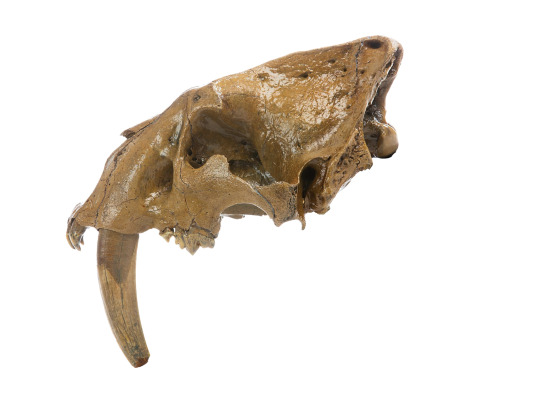
You can pretty clearly see the division between the enamel-covered portion of the teeth and the cementum. In modern felids, this cementoenamel junction is roughly where the gum line ends, and this is also what Riviere and Wheeler 2005 concluded for Smilodon. So if we take that and apply a gumline to this skull, it looks like this:

Now that looks like a pretty deep gumline! The full canines of Smilodon don't necessarily need to be covered by lips; even though they are covered by enamel, it's a very thin coating that doesn't require extensive hydration. This is also the case with the fangs of musk deer and Chinese water deer, who have their canines hanging on the outside of the mouth. These fanged deer, as well as tusked synapsids like walruses and Tiarajudens, have canines that project far beyond the bottom of the lower jaw (see below for the alternative) - and none have the massive bloodhound lips you may see around for Smilodon.
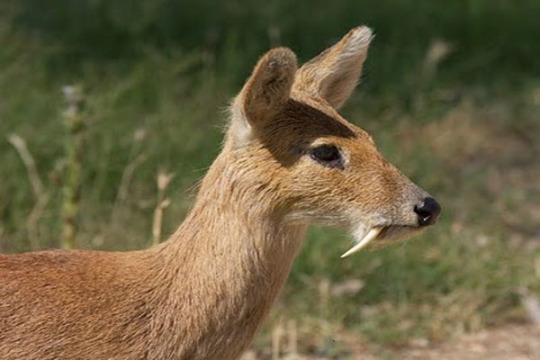
The gums, however, would need to be hydrated and covered by the lips. So that pink line could be an indicator of the minimum extent of the lip margin. But what I notice about these gumline comparisons is that we're looking only at the skull. If you bring in Smilodon's mandible and articulate it so that the mouth is closed...
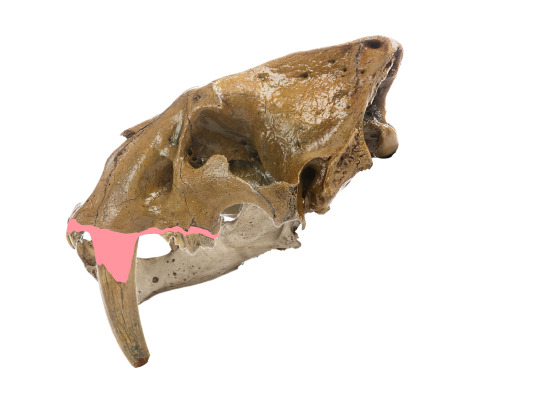
The gumline doesn't go below the margin of the lower jaw. So the upper lips would not need to droop beyond the margin of the lower jaw. And as discussed above, the rest of the canines wouldn't necessarily need to be covered. Goodbye bloodhound Smilodon. This is consistent with how the lips do not droop beyond the margin of the mandible in any "saber-toothed" animal. Fanged deer and walruses have exposed canines. Clouded leopards keep their impressively-sized canines in the mouth; while the lips are relatively big, they don't droop over the lower jaw...
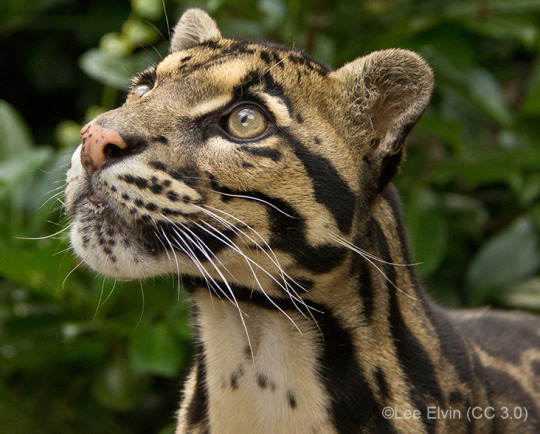
And saber-toothed animals that aren't smilodontines - including other true sabercats like Homotherium - don't actually have teeth that project beyond the bottom of the lower jaw (accounting for tooth slippage). Most of them have a deepened "chin" that follows the sabers. So it's possible, if not likely, that these animals simply had sabers covered by the soft tissue of the lower jaw when the mouth was closed. That would keep the teeth and gums moist regardless of how far down the gums went. Even if the teeth were exposed, the upper lips still wouldn't need to go very far down to keep the gums moist (you can see where the cementoenamel joint is on the Eusmilus skull replica in the lower right).
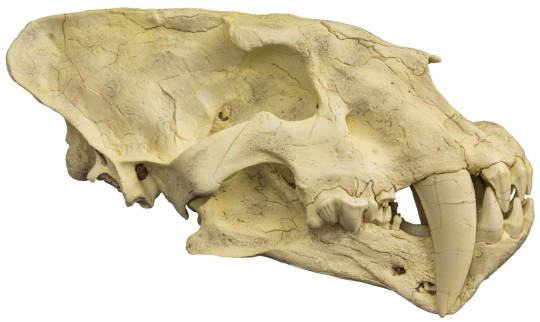
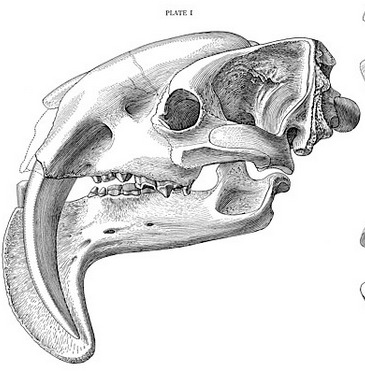

(top: Homotherium; bottom left, Thylacosmilus)
Now let's take the rigorous reconstruction of Smilodon from Turner et al. 2011 - and overlay it over the image above, to see if "traditional" Smilodon lips would cover all of this expanded gumline or not.
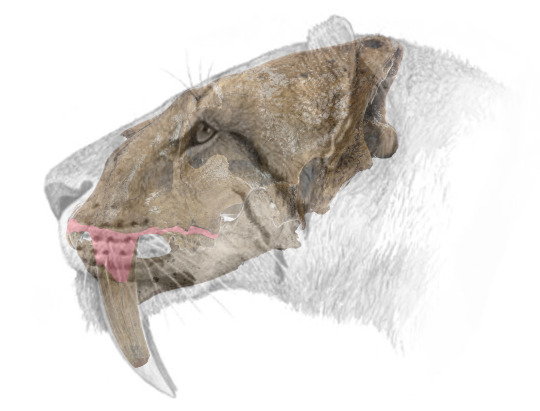
That looks like a pretty close match, I'd say! Being generous (and looking at clouded leopards as a very rough guide), I can see the margin of the upper lip maybe going like this. Lippier than usually pictured, but not shockingly so.
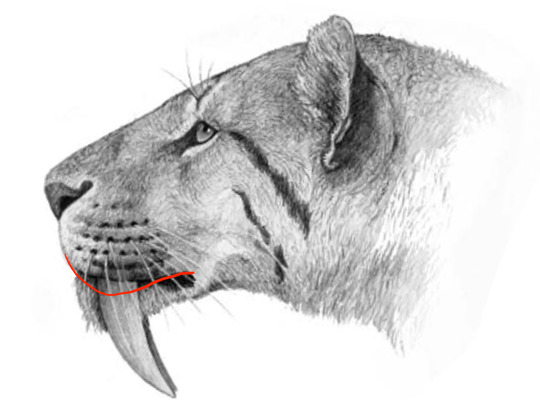
So not much would change.
Now, why would Smilodon need such deep gums? Simple - the longer a tooth is, the easier it is to break off. So more extensive gum tissue would help stabilize the sabers in the mouth. Which makes sense. The current model for sabercat predation is that they would subdue prey using their beefy muscled forelimbs, and only use the sabers at the end for the killing neck-puncturing bite. Don't wanna break them beforehand.
121 notes
·
View notes
Text

刻(とき)の狭間 ~回鍋肉の中華プレート~/Rift of Time~Chinese Double-Cooked Pork Plate~ (unofficial translation)
was a Gundam Café dish representing the intersecting fates of Lalah, Amuro and Char.
The lettuce wrapped stir-fry shaped like Lalah's spacecraft Elmeth was available from July 14th to September 5th 2016 at the restaurants' Akihabara and Osaka locations for 1296 yen (tax included).
The beam saber skewer was not to be taken home.
#blorbo scran#コラボカフェ#anime#gundam#ガンダムカフェ#ガンダム#機動戦士ガンダム~宇宙世紀名場面フェア 夏のスタミナ料理~#gundam cafe#0079 gundam#Lalah Sune#ララァ・スン#Char Aznable#シャア・アズナブル#Amuro Ray#アムロ・レイ
34 notes
·
View notes
Text
1850s rendering by Japanese ukiyo-e style prints and painting master Utagawa Kuniyoshi of Hu Sanniang (扈三娘), aka. "Ten Feet of Blue," the fictional character from the Chinese classic novel Water Margin said to hail from Shandong, using her 2 saber swords to block a hail of arrows flying in her direction.

20 notes
·
View notes
Text
they really want that chinese playerbase money huh?
I mean they are a business, can't fault them for trying to get money
...but I can still give them shit for it (what you afraid of hurting someone's feeling? it's a business, it doesn't have feelings )

like y'all trying to get that Wuthering Waves money
like I've heard people say they want more furries, more fat girls, more melanin... and dislyte ass wasn't listening to none of that
maybe we'll get something nice for Halloween
we seriously getting Alt Saber Li Ling before a Korean Legendary?
why is design team struggling this much to make a bird furry? like everytime a bird esper shows up they're bit more bird like... but they're still holding back for some reason. It's gonna be like 2050 before they just give us an bird man
neat lightmode skin Yun Chuan
holy shit is that au pinkie pie?
...
but for real what's going on? like we already had Chinese Espers (we ended 2023 with chinese story, we started 2024 with chinese story then we had a 4 parter chinese story arc) and then Mesopotamian Espers 4 part story arc. It's clearly suppose to be someone else turn. Why are we already back at Chinese so soon?
33 notes
·
View notes